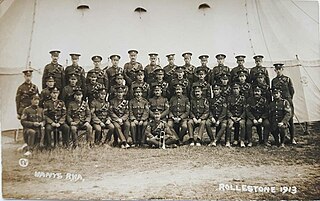J Battery Royal Horse Artillery are a Close Support Battery of 3rd Regiment Royal Horse Artillery. They were currently based in Caen Barracks in Hohne, Germany.
M (Headquarters) Battery Royal Horse Artillery is the Headquarters Battery of 3rd Regiment Royal Horse Artillery, part of the Royal Horse Artillery of the British Army. As of 2015, it is based at Albemarle Barracks, Northumberland, England. The Battery Commander is Maj B Johnston RHA.

The 2nd Cavalry Division was a division of the regular British Army that saw service in the Peninsular War and in World War I, when it also known as Gough's Command, after its commanding general. It was part of the British Expeditionary Force that served in France in from 1914 to 1918. It was involved in most of the major actions where cavalry were used as a mounted mobile force, and also many where the troops were dismounted and effectively served as infantry.
Q Battery is the Headquarters Battery of 5th Regiment Royal Artillery in the Royal Artillery. It currently serves as the Headquarters Battery for the British Army's Surveillance and Target Acquisition regiment.

Z Battery RA was a Battery of 5th Regiment Royal Artillery in the Royal Artillery. It had the Surveillance and Target Acquisition role and was equipped with various weapon platform locating equipment using radars and acoustic sound ranging assets.
XIII Brigade, Royal Horse Artillery was a brigade of the Royal Horse Artillery which existed in the early part of the 20th century. It was dissolved at the outbreak of World War I as its constituent batteries were posted to other formations.
XIV Brigade, Royal Horse Artillery was a brigade of the Royal Horse Artillery which existed in the early part of the 20th century. It had been dissolved before World War I but was reformed for the war. It served with 7th Division on the Western Front before becoming XIV Army Brigade, RHA in February 1917. It was disbanded at the end of the war.
VII Brigade, Royal Horse Artillery was a brigade of the Royal Horse Artillery which existed in the early part of the 20th century. It served with 1st Cavalry Division throughout World War I and was reorganized post-war before being dissolved. A related unit 7th Regiment, RHA had a brief existence post-World War II, before 7th Parachute Regiment, RHA was formed in 1961.
6th Regiment, Royal Horse Artillery was a Regiment of the Royal Horse Artillery that acted as a training formation during World War II. It was the last RHA unit to serve in India between December 1945 and April 1947, before being redesignated as 6th Field Regiment, Royal Artillery in Palestine in 1948.
V Brigade, Royal Horse Artillery was a brigade of the Royal Horse Artillery which existed in the early part of the 20th century. It served with 8th Division on the Western Front in World War I before becoming V Army Brigade, RHA in January 1917. It was reformed after the war but was disbanded in October 1928.
III Brigade, Royal Horse Artillery was a brigade of the Royal Horse Artillery which existed in the early part of the 20th century. It served with the 1st and 2nd Cavalry Divisions on the Western Front throughout World War I.
2nd Regiment Royal Horse Artillery was a regiment of the Royal Horse Artillery that served in the Second World War. It saw action in France, Greece, North Africa and Italy. It was redesignated as 2nd Field Regiment, Royal Artillery in 1958.
I Brigade, Royal Horse Artillery was a brigade of the Royal Horse Artillery which existed in the early part of the 20th century. It was dissolved at the outbreak of World War I as its constituent batteries were posted to other formations.
V Lowland Brigade, Royal Field Artillery was a field artillery brigade formed from three Territorial Force Royal Horse Artillery batteries in January 1916. It was assigned to the 52nd (Lowland) Division to replace I Lowland Brigade, RFA (T.F.) and joined the division in Egypt.

The Hampshire Royal Horse Artillery was a Territorial Force Royal Horse Artillery battery that was formed in Hampshire in 1909. It saw active service during the First World War in Egypt and Palestine from 1916 to 1918, initially as field artillery with 52nd (Lowland) Division before being converted back to horse artillery and serving with the Yeomanry Mounted Division and 1st Mounted / 4th Cavalry Division. A second line battery, 2/1st Hampshire RHA, served on the Western Front in 1917 and 1918 as part of an Army Field Artillery Brigade. Post-war, it was reconstituted as a Royal Field Artillery battery.
The Essex Royal Horse Artillery was a Territorial Force Royal Horse Artillery battery that was formed in Essex in 1908. It saw active service during the First World War in Egypt and Palestine from 1916 to 1918, initially as field artillery with 52nd (Lowland) Division before being converted back to horse artillery and serving with the 2nd Mounted / 5th Cavalry Division. A second line battery, 2/1st Essex RHA, served on the Western Front in 1917 and 1918 as part of an Army Field Artillery Brigade.
G Parachute Battery Royal Horse Artillery is a close support battery of 7th Parachute Regiment Royal Horse Artillery, part of the Royal Horse Artillery of the British Army, currently based in Merville Barracks in Colchester.
I Parachute Battery Royal Horse Artillery is the Headquarters battery of 7th Parachute Regiment Royal Horse Artillery, part of the Royal Horse Artillery of the British Army, currently based in Albemarle Barracks in Newcastle Upon Tyne.
H Battery Royal Horse Artillery is a battery of 1st Regiment Royal Horse Artillery, part of the Royal Horse Artillery of the British Army. As of 2015, it is based at Albemarle Barracks, Northumberland, England and is equipped with GMLRS.
T Battery Royal Artillery is an air defence battery of the Royal Artillery that serves with the British Army's 12 Regiment Royal Artillery. It is stationed at Baker Barracks, Thorney Island, West Sussex.


